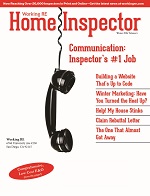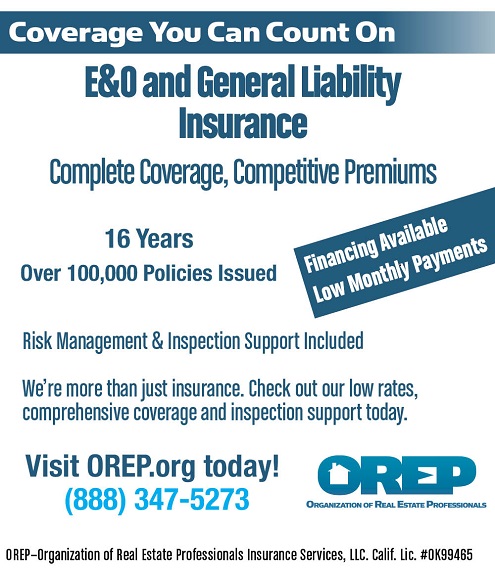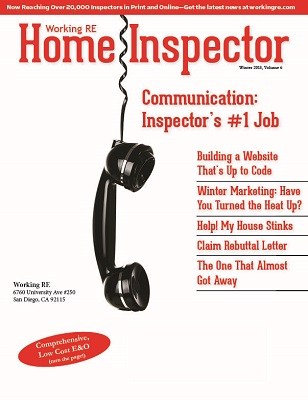 |
> E&O/GL Insurance for Home Inspectors Competitive Rates, Broad Coverage, Free Risk Management, online inspection support for tough questions, discounts on education and more… Professional Coverage, Competitive Pricing Shop OREP today! |
Editor’s Note: This story appears in Working RE Home Inspector’s September Print Edition. OREP insureds enjoy it free along with many other business and risk management benefits! WRE reaches 20,000+ Home Inspectors in Print and Online!
War on Radon and What You Need to Know
By Carolyn Koke, Spruce Environmental Technologies, Inc.
Lung cancer is the leading cancer killer in both men and women. According to American Lung Association, American Cancer Society, and Centers for Disease Control and Prevention, an estimated 158,040 American citizens will die from lung cancer this year—more than colorectal, breast and prostate cancers combined.
One of the leading causes of lung cancer is radon. Radon, a radioactive gas that is present in homes and other buildings, is the #1 environmental health threat and the #1 cause of lung cancer for non-smokers. Although radon is found in all buildings, the U.S. Environmental Protection Agency (EPA) recommends reducing the radon when test results are 4.0 picocuries/ Liter (pCi/L) or higher. EPA suggests that homeowners consider fixing the radon if the level is 2.0 to 4.0 pCi/L.
Home inspection professionals are in an ideal position to help turn around these statistics by making potential buyers—and sellers—aware of the hidden dangers of radon and the need for testing and mitigation. A home that has been mitigated to reduce radon levels is a safer, healthier home. The existence of a radon system in a home is a benefit to potential buyers and a selling point for agents and sellers.
This presents an opportunity for home inspectors to help educate buyers, sellers, and real estate agents, while growing their business and offering a service that sets them apart from the competition.
Invisible Killer
In 1982 the world learned about a fatal virus that became known as AIDS. It took over a year to determine how it was transmitted, and another year before a screening blood test was developed. As the death toll climbed and fear grew, so did a worldwide outcry for public health protection and action. In 1988, 20,786 people in the U.S. died from HIV and AIDS (NY Times). In 2014, 6,721 people in the U.S. died from HIV and AIDS. (CDC)
In 1988, the U.S. EPA estimate of deaths due to radon-induced lung cancer was 21,000 per year. That number of deaths has been the same – 21,000 – every year since then. The lack of awareness of the dangers of radon and the absence of concrete actions to prevent radon-induced lung cancer is a problem that needs to be addressed.
Federal Programs
Congress passed the Indoor Radon Abatement Act in 1988. However, little progress has been made in reducing the number of high radon homes and the number of lives at risk. In 2008, the U.S. EPA Office of the Inspector General released a report entitled, “More Action Needed to Protect Public from Indoor Radon Risks.” The report observed that new home construction has outpaced the installation of radon mitigation systems. It’s important to remember that the principal driver of radon awareness, research and reduction activities, EPA State Indoor Radon Grant (SIRG), has been capped at a meager $8 million annually for years.
In 2011, the U.S. EPA launched the Federal Radon Action Plan (FRAP) to provide a framework for increased radon awareness and reduction activities within nine federal agencies. Several milestones were achieved. The EPA reported that 88% of FRAP goals were achieved. Additionally, the program provided, “direct and immediate effects reaching at least 1.6 million homes, schools and childcare facilities with federal guidance and incentives and, in 12.5% of those units, testing and mitigating when necessary.”
Other Initiatives
To continue the work of the FRAP, in 2015 the National Radon Action Plan (NRAP) was launched by the American Lung Association. The official goal of the NRAP is to mitigate five million high radon homes and save 3,200 lives from lung cancer annually by 2020, working together with federal agencies and several non-profit organizations.
One of the most active organizations mobilized against radon is Cancer Survivors Against Radon (CanSAR), whose mission is to “help spread the importance of radon testing so no one will hear the words, ‘you have cancer [due to radon exposure]’.” CanSAR was founded in 2005 by Elizabeth Hoffman, who was diagnosed with Stage IIIA lung cancer in 2003. A never-smoker with no family history of lung cancer, Hoffman tested her home for radon. She was shocked to learn that she had been living with more than twice the U.S. EPA’s action level of 4.0 pCi/L.
CanSAR supports lung cancer victims and their families and advocates for the passage of radon legislation. Their keystone project is a drive for states to each pass a Radon Awareness Act. In two states, Illinois and Minnesota, where CanSAR was instrumental in getting Radon Awareness Acts passed, the results have been significant. In Illinois, within the first year, radon testing increased by 29% and mitigation by 26%. In Minnesota, there was a 400% increase in radon mitigations.
On August 1, 2017, CanSAR began a new radon awareness campaign called Women Against Radon, with the purpose of making women aware of the risk to them and their families. The American Lung Association estimates that every five minutes, a woman in the U.S. is told she has lung cancer. In addition, the number of women dying from lung cancer each year has nearly doubled over the past 30 years. Many of these deaths are preventable. The easiest form of prevention is testing for radon.
Women Against Radon committee member Pat Everett states, “It’s time to show our outrage. We are asking everyone to join the fight against lung cancer. It’s time to stop the tens of thousands of deaths caused by radon, the invisible killer.”
What Inspectors Can Do
Home inspectors are, in many ways, on the front lines of the fight against radon as they often inspect homes which may have dangerously high radon levels. This is an opportunity for home inspectors to help educate home buyers, sellers, and real estate agents on the dangers of radon, while also providing a valuable service that can help inspectors grow their businesses and increase their revenue. What will you do to help save lives? I hope that you will join the war against radon.
About the Author
Carolyn Koke has been in the radon industry for more than 20 years. She is a Past President of the American Association of Radon Scientists and Technologists. Ms. Koke works for Spruce Environmental Technologies, Inc., which manufactures and distributes radon testing products and specialized fans under the AccuStar, RadStar and RadonAway brands. AccuStar’s long-term Alpha Track radon test device was rated number 1 in its category by a leading national consumer advocacy group.
Free Risk Management Online Course
Claims and Complaints: How to Stay Out of Trouble
Available Now
Presenter: David Brauner, Senior Insurance Broker OREP
David Brauner, Senior Broker at OREP, shares insights and advice gained over 25+ years of providing E&O insurance for inspectors, showing you how to protect yourself and your business. Watch Now!
Note: The Summer 2018 issue of Working RE Inspector mailed to over 20,000 home inspectors nationwide. OREP Insureds enjoy guaranteed delivery of each print magazine and many more benefits.



